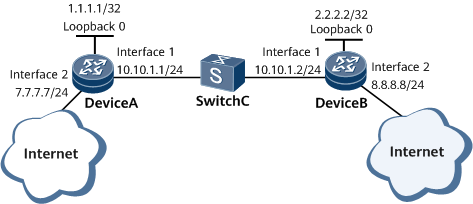Example for Configuring Dynamic BFD for IPv4 Static Routes
Dynamic BFD for IPv4 static routes can fast detect link failures.
Networking Requirements
On the network shown in Figure 1, DeviceA is connected to DeviceB through SwitchC. It is required that DeviceA communicate with other Devices through static default routes and that a BFD session be established between DeviceA and DeviceB to detect link failures.
Precautions
When configuring dynamic BFD for static routes, note the following:
BFD has been enabled globally.
The parameters configured on the two ends of a BFD session must be consistent.
Configuration Roadmap
The configuration roadmap is as follows:
On DeviceA, configure an IPv4 static route to DeviceB.
Configure dynamic BFD for static routes.
Data Preparation
To complete the configuration, you need the following data:
Peer IP address to be detected by BFD
Default values of the local detection multiplier and of the minimum intervals at which BFD Control packets are sent and received
Procedure
- Configure an IP address for each interface. For configuration details, see Configuration Files in this section.
- Configure static routes.
# On DeviceA, configure a static route to 2.2.2.2/32.
[~DeviceA] ip route-static 2.2.2.2 32 10.10.1.2 [*DeviceA] commit
# Check the IP routing table of DeviceA. The following command output shows that the static route exists in the routing table.
[~DeviceA] display ip routing-table Route Flags: R - relay, D - download to fib, T - to vpn-instance, B - black hole route ------------------------------------------------------------------------------ Routing Table : _public_ Destinations : 10 Routes : 10 Destination/Mask Proto Pre Cost Flags NextHop Interface 1.1.1.1/32 Direct 0 0 D 127.0.0.1 LoopBack0 2.2.2.2/32 Static 60 0 RD 10.10.1.2 GigabitEthernet0/1/0 127.0.0.0/8 Direct 0 0 D 127.0.0.1 InLoopBack0 127.0.0.1/32 Direct 0 0 D 127.0.0.1 InLoopBack0 127.255.255.255/32 Direct 0 0 D 127.0.0.1 InLoopBack0 255.255.255.255/32 Direct 0 0 D 127.0.0.1 InLoopBack0 10.10.1.0/24 Direct 0 0 D 10.10.1.1 GigabitEthernet0/1/0 10.10.1.1/32 Direct 0 0 D 127.0.0.1 GigabitEthernet0/1/0 10.10.1.2/32 Direct 0 0 D 10.10.1.2 GigabitEthernet0/1/0 10.10.1.255/32 Direct 0 0 D 127.0.0.1 GigabitEthernet0/1/0
# On DeviceB, configure a static route to 1.1.1.1/32.
[~DeviceB] ip route-static 1.1.1.1 32 10.10.1.1 [*DeviceB] commit
- Configure dynamic BFD for static routes.
# On DeviceA, bind the static route to the BFD session.
[~DeviceA] bfd [*DeviceA-bfd] quit [*DeviceA] ip route-static bfd 10.10.1.2 local-address 10.10.1.1 [*DeviceA] ip route-static 2.2.2.2 32 10.10.1.2 bfd enable [*DeviceA] commit
# On DeviceB, bind the static route to the BFD session.
[~DeviceB] bfd [*DeviceB-bfd] quit [*DeviceB] ip route-static bfd 10.10.1.1 local-address 10.10.1.2 [*DeviceB] ip route-static 1.1.1.1 32 10.10.1.1 bfd enable [*DeviceB] commit
- Verify the configuration.
# After the preceding configuration, on DeviceA and DeviceB, you can view that the BFD session has been established and is Up and that the static routes have been bound to the BFD session.
Use the command output DeviceA as an example.
[~DeviceA] display bfd session all verbose (w): State in WTR (*): State is invalid ------------------------------------------------------------------------------ (Multi Hop) State : Up Name : dyn_8193 ------------------------------------------------------------------------------ Local Discriminator : 8193 Remote Discriminator : 8193 Session Detect Mode : Asynchronous Mode Without Echo Function BFD Bind Type : Peer IP Address Bind Session Type : Dynamic Bind Peer IP Address : 10.10.1.2 Bind Interface : - Bind Source IP Address : 10.10.1.1 FSM Board Id : 0 TOS-EXP : 7 Min Tx Interval (ms) : 50 Min Rx Interval (ms) : 50 Actual Tx Interval (ms): 50 Actual Rx Interval (ms): 50 Local Detect Multi : 3 Detect Interval (ms) : 150 Echo Passive : Disable Acl Number : - Destination Port : 4784 TTL : 253 Proc Interface Status : Disable Process PST : Disable WTR Interval (ms) : 0 Local Demand Mode : Disable Active Multi : 3 Last Local Diagnostic : No Diagnostic Bind Application : STATICRT Session TX TmrID : 0 Session Detect TmrID : 0 Session Init TmrID : - Session WTR TmrID : - Session Echo Tx TmrID : - Session Description : - ------------------------------------------------------------------------------ Total UP/DOWN Session Number : 1/0
Configuration Files
DeviceA configuration file
# sysname DeviceA # bfd # interface GigabitEthernet0/1/0 undo shutdown ip address 10.10.1.1 255.255.255.0 # interface GigabitEthernet0/1/8 undo shutdown ip address 7.7.7.7 255.255.255.0 # interface LoopBack0 ip address 1.1.1.1 255.255.255.255 # ip route-static bfd 10.10.1.2 local-address 10.10.1.1 ip route-static 2.2.2.2 32 10.10.1.2 bfd enable # return
DeviceB configuration file
# sysname DeviceB # bfd # interface GigabitEthernet0/1/0 undo shutdown ip address 10.10.1.2 255.255.255.0 # interface GigabitEthernet0/1/8 undo shutdown ip address 8.8.8.8 255.255.255.0 # interface LoopBack0 ip address 2.2.2.2 255.255.255.255 # ip route-static bfd 10.10.1.1 local-address 10.10.1.2 ip route-static 1.1.1.1 32 10.10.1.1 bfd enable # return

